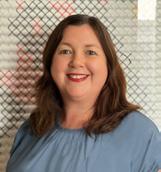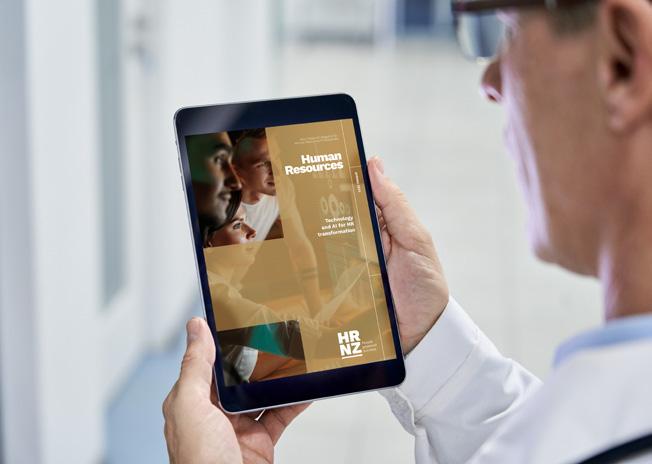
Human Resources New Zealand’s Magazine for Human Resources Professionals WINTER 2024
Find your path: building the HR pipeline



O u r H R w o r l d i s f l e x i b l e i n n a t u r e a n d w e m u s t b e f l e x i b l e i n p r a c t i c e .
T h e r e w i l l b e t i m e s w h e n y o u n e e d a n a d d i t i o n a l r e s o u r c e t o m e e t
v a r y i n g , u n p l a n n e d b u s i n e s s n e e d s a n d p r o j e c t s .
O u r t a l e n t b a n k e n a b l e s u s t o p e r f e c t l y m a t c h p e o p l e t o a j o b r o l e ,
s p e c i f i c a l l y t a k i n g i n t o c o n s i d e r a t i o n s k i l l s e t , s e c t o r e x p e r i e n c e ,
c u l t u r e f i t a n d a t t i t u d e . T h i s l e a v e s o u r c l i e n t s s a f e i n t h e k n o w l e d g e
t h a t w h a t e v e r t h e i r i n t

e r i m H R n e e d s , w e h a v e t h e b e s t p e r s o n t o
q
t s o f
e . R e
R p e o p l e - e x p e r t s i n b o t h p e r m a n e n t a n d f l e x i b l e H R r e c r u i t m e n t . C a l l u s t o d i s c u s s h o w w e c a n h e l p y o u r b u s i n e s s t h r i v e . + 6 4 9 4 2 1 1 0 0 2 C O N T A C
: r h r p @ r e c r u i t h r p e o p l e . c o . n z W e a r e h e r e t o h e l p , p l e a s e g e t i n t o u c h w i t h T a s h a n d t h e t e a m
easier, with recruitHRpeople Meet
workforce
m e e t t h e r e
u i r e m e n
t h e r o l
c r u i t H
T U S
Interim HR recruitment just got
our flexible
From the editor
For me, my career path into HR was quite an obvious one. I have always loved talking with people and understanding what made them tick, so human resources seemed the perfect place. I came from a family of scientists, so I was going out on a limb by pursuing a career in a field so ‘unmeasurable’ as HR. It made sense to me, though. At school, I wasn’t aware you could do a university degree in HRM, so instead, I studied languages (French and German) so I could communicate with more people and understand what made them tick.
After graduating, I was offered a place on the Boots Graduate Training Programme in the United Kingdom. This involved me undertaking four work placements in four locations over two years. I got to experience it all: from employee relations (like dealing with retail assistants fighting on the shop floor in London) to training and development (devising an employee reward and recognition scheme in Birmingham) and everything in between, I learnt the ropes of HR. I got to experiment, say yes to as
many opportunities as possible and find some great mentors.
As with any career, it’s never linear – and like my father used to say –your career is like a tree: you can go down one branch, and if you need or want to change it, you can choose another branch! And that’s pretty much what I’ve done. From HR Business Partner for a multinational company to home educator to writer and editor (including of this HR magazine!), I’ve certainly tried different branches. The common thread: people and how they tick.
This issue of Human Resources magazine is packed with great examples of different career paths. We hear from five HR professionals who are all following their own unique paths. NZ HR Awards winner Julia Stones shares her wisdom on how to build a fulfilling career, and Jackie Lloyd from the Institute of Directors asks how we can continue to build the pipeline of HR professionals. And be sure to check out the opinion piece from Danni Ermilova Williams, former New Zealand HR Professional of the Year, who shares her thoughts on solving the homogeneity of HR.
Focusing on where we’re heading in our careers is vital – I hope this issue provides helpful tools and inspiration!
Kathy Catton
Managing Editor
Kathy.Catton@hrnz.org.nz

MANAGING EDITOR
Kathy Catton
Ph: 021 0650 959
Email: kathy.catton@hrnz.org.nz
ADVERTISING & SPONSORSHIP
Nikita Barends
Ph: (04) 802 3954
Email: nikita.barends@hrnz.org.nz
DESIGN
Jen McBride, Jn Creative
Email: jen@jn-creative.co.nz
PROOFREADER
Jenny Heine
Email: jenny@heine.co.nz
SUBSCRIPTION ENQUIRIES
Email: comms@hrnz.org.nz
PUBLISHER
Human Resources is published quarterly by Human Resources New Zealand PO Box 11-450, Wellington Ph: 0800 247 469
comms@hrnz.org.nz
hrnz.org.nz
nz.linkedin.com/company/hrnz
instagram.com/hrnzphotos
The views expressed in Human Resources are not necessarily those of Human Resources New Zealand, nor does the advertisement of any product or service in this magazine imply endorsement of it by Human Resources New Zealand.
Copyright © Human Resources New Zealand Inc. Vol 29 No: 2
ISSN 1173-7522
WINTER 2024 | HUMAN RESOURCES 1

Everything is going up in price these days and employee benefits are no exception.
We know businesses are under pressure to look after their people but also keep costs down.
As one of New Zealand’s most dynamic thinking risk advisory firms we have access to a range of insurers who can provide comprehensive insurance without breaking the bank. Whether its health, life, critical illness, or income protection we have you covered.
Need an intervention?
Contact Kathy for a no obligation chat 022 506 9249 kathy.pascoe@icib.co.nz
icib.co.nz
Staff health insurance premiums gone up? It’s time for an intervention!
TOP OF MIND
Nick McKissack

Leading up to the general election last year, I spoke to several younger people about their voting preferences. There was a noticeable inclination to vote Green, which was later borne out in the election results. The Green Party received just over 11 per cent of the vote and won seats in both Auckland and Wellington Central. Such are the vagaries of our democracy; these young voters have no voice in the new government. This is something that we should be concerned about.
I’m not talking about politics here; it’s just there is potentially a large demographic that is not being heard in today’s decisionmaking. This demographic will be the people who inherit the future outcomes of decisions made today.
The narrative of governance and decision-making has traditionally been monopolised by the older generation. Experience and wisdom have been the benchmarks for leadership, relegating the younger demographic to the sidelines. This age-old paradigm is fast losing its relevance in a world where the consequences of decisions made today will affect generations to come.
The urgency to involve rangatahi (the younger generations) in decision-making processes stems
from the simple truth that they are the ones who will inherit the legacy, be it a legacy of prosperity or one of challenges and missed opportunities. Whether it’s climate change, socio-economic disparities or technological advancements, the ramifications of today’s choices will be most keenly felt by the youth of today and tomorrow.
Empowering rangatahi to take the reins of leadership is a strategic imperative. Their fresh perspectives, innovative ideas and unwavering idealism inject vitality into stagnant systems, challenging the status quo and fostering much-needed dynamism.
You’ll often hear disparaging perspectives about the characteristics of the younger generation. It’s a useful way to dismiss their opinions. My experience of working or interacting with younger people is they provide new perspectives and energy that improve any outcomes I’m trying to achieve. It’s essential to give our younger people the autonomy to lead and make decisions and not always overlay our own opinions about their choices.
This edition of Human Resources magazine is about career progression for HR professionals and the importance of
professional accreditation. The HRNZ professional accreditation programme is based on our capability framework: The Path When developing the framework, our community of HR contributors was clear that this framework should reflect a bold path for the future of HR.
Young HR professionals will lead people outcomes in our workplaces in the future. It’s important that we support them fully in their career progression and make sure they have a voice in how the practice of HR evolves into the future.
The future belongs not just to those who have steered the ship thus far but also to those who will inherit the helm. Empowering young people to take leadership in deciding the future is both a moral imperative and a pragmatic necessity. Their voices must be heard, their perspectives valued and their potential unleashed. It is their right to help shape their own future.
FROM THE HRNZ CHIEF EXECUTIVE
GOVERNS WINTER 2024 | HUMAN RESOURCES 3

Features
28 Do you know what your career path looks like?
Julia Stones, Executive
Search Professional and Career Coach, shares her career journey and how a powerful career tool can make all the difference
32 Solving the homogeneity of HR
Danni Ermilova Williams, Change Consultant and Creator, questions the true role of HR and how we can solve the problem of homogeneity within the profession
36 Navigating HR pathways
Editor Kathy Catton spoke with five HR professionals all at different stages of their careers
44 Boundaryless HR
Daniel Chee and Millie Gracie from Deloitte’s Human Capital practice explore what ‘boundaryless HR’ means and how organisations can implement this concept



22 24
In this issue 4 HUMAN RESOURCES | WINTER 2024
44



14 Seize the day
Jackie Lloyd, President of the Institute of Directors, outlines why it’s a great time to be in HR
16 Find your true north Bridget Williams at Bead and Proceed looks at how finding your place and making a difference are a big win for sustainability
18 Employment Law Update
Jack Rainbow, Associate at Dundas Street Employment Lawyers, examines performance management and how to get it right
20 Research Update
Paula O’Kane at the University of Otago reports back on the latest research into the HR business partner role
22 Immigration Law Update Vienna Tse, from Cavell Leitch Lawyers, outlines the sudden changes to the work visa scheme
Professional Development
Gillian Brookes looks at governance and the role of HR in
HRNZ Capability Framework
12 Why HRNZ is introducing a new professional standard
Alice Croucher, HR Research Analyst at HRNZ, outlines why the change in professional accreditation
48 Dear Human Resources... Aidan Stoate, from Inspire Group, shares his heartwarming insights into being a people leader
Check out our banners and footers!
Our articles are all tagged with the levels (see above), from our new Capability Framework, The Path
For more information, check out our website.
14 12
governance
24
Spotlight
WINTER 2024 | HUMAN RESOURCES 5 GOVERNS SHAPES LEADS DESIGNS ADVISES DELIVERS
Shaping the Profession 1 From the Editor Kathy Catton 3 Top of Mind Chief Executive Nick McKissack shares his thoughts 8 Quick Reads
latest updates
keep
current in the world of HR 10 Accredited Members
recently Accredited Professional Member
Chartered Member
The
to
you
HRNZ caught up with a
and a recently
Transforming the way organisations learn
We’re on a mission to help companies revolutionise the way they train and grow their people.
inspiregroup.co.nz

8 Quick Reads 10 Accredited Members 12 Why HRNZ is introducing a new professional standard 14 Seize the day 16 Find your true north 18 Employment Law Update 20 Research Update 22 Immigration Law Update 24 Professional Development Spotlight 48 Dear Human Resources… WINTER 2024 | HUMAN RESOURCES 7 Shaping the profession
Quick reads
IS WFH KEEPING US WELL?
Arecent Frog Recruitment poll shows that 67 per cent of those surveyed admitted to spending time on life admin tasks while working from home.
In the survey of 1,020 New Zealand employees, one-third revealed they shave more than three hours a week off their housework and hobbies, with 40 per cent prioritising washing and laundry and a quarter focusing on cleaning and tidying up.
“If employers are worried about the productivity of a remote workforce, these statistics will fuel those fears,” says Frog Recruitment Managing Director Shannon Barlow.
“However, they need to consider the bigger picture, such as the impact on employee satisfaction and engagement.
“Giving workers the chance to get on top of life admin can pay big dividends when it comes to workplace wellbeing. Trying to juggle full-time work with running a household in our increasingly pressured world can be overwhelming for many people, and allowing them to get on top of it supports their mental and emotional wellbeing, reduces burnout, and improves workplace productivity.”
The poll also explored the financial considerations of working from home and found that one-third of workers are saving over $100 per week on travel, parking and meal costs.
CHANGES TO WORK VISA SCHEME
Immigration New Zealand (INZ) announced large-scale changes to the Accredited Employer Work Visa (AEWV) scheme in April. These policy changes have far-reaching implications for businesses. Under the AEWV scheme, a range of verification steps are involved in the application process, including accreditation, Job Check and work visa steps, as well as post-accreditation checks. According to INZ’s website, 212 active investigations on accredited employers are currently under way, 255 employers have had their accreditation revoked and 82 have had their accreditation suspended. Revocations and suspensions can occur if there are breaches of accreditation standards. INZ points out on its website that “the vast majority of employers are doing the right thing and treat their migrant workers fairly and well”.
For more information on the changes and what they may mean for your organisation, see our article on page 22.

GREATER RECOGNITION OF MOTHERHOOD EXPERIENCES NEEDED
New research released in April examines the lived experiences of mothers in leadership positions and finds that more recognition is required to achieve true gender balance at leadership levels.
The research, conducted by Dr Amanda Sterling, explores mothers’ experiences in leadership, and how those experiences (eg, of pregnancy, birth, breastfeeding and care of very young children) could challenge what we consider ‘normal leadership’. Amanda goes
on to say that if organisations applied this understanding, it would open up greater opportunities for the inclusion of women in leadership roles.
“Research shows us that motherhood is still the biggest dropping-off point for women in leadership,” says Amanda. “Therefore the biggest challenge organisations have to solve, if they want more female leaders and wish to be truly inclusive, is how they support mothers within those higher-pressure leadership roles. This research reveals

how explicitly recognising, and actively supporting, embodied experiences within leadership could lead to better outcomes for women, as well as the organisations that employ them.”
The full report is available here.
8 HUMAN RESOURCES | WINTER 2024
Dr Amanda Sterling
Arecent study by AgeCalculator.com using OECD labour market exit age data shows that New Zealanders are staying in work longer, with the average age rising to 67 years in 2020, up from 61 in 2000. A mandatory retirement age was eliminated in New Zealand in 2000 allowing older people to continue in paid work. Although government superannuation kicks in at age 65, people are staying in work longer.
TAKE A BREAK –READ AND LISTEN
Ready for a mini break from your desk? These three books and one podcast provide valuable guidance to help you in your HR role.
As Retirement Commission policy lead Michelle Reyers says, “New Zealand has got a number of policies in place that actually encourage older people to continue in paid work that don’t actually exist in other countries. And this is really giving people flexibility and choice to decide when they’re going to exit from paid work.”



Career Unstuck by Charlotte
Blair
Whatever stage of your working life you are at, this book aims to identify what’s keeping you stuck in your career and evaluate your mindset and beliefs. The author seeks to help you reimagine what work and life could be and provides tools to help you play to your strengths and find the work you love. Each chapter has a summary and ends with actions and questions to consider. Mini case studies are also included of people’s journeys along the way.

Across the Board – Institute of Directors New Zealand
This podcast challenges some of the stereotypical thinking on what goes on in the boardroom, how governance affects our lives and why we should take notice, now more than ever. Across the Board is presented by Institute of Directors CEO Kirsten Patterson and award-winning documentary producer Sonia Yee. Topics covered in the seven-episode series include how directors set the benchmark for success, the importance of climate governance and the cultural makeup of boardrooms.

An
Australian and New Zealand Human
Resource Management Guide to Work and Health and Safety by
Lynnaire Sheridan
This book presents a historical overview of work health and safety, outlines its main theories and principles and then explains how it can be operationalised through adopting and enacting a safety management system. It puts workers, and their health, at the centre of work, health and safety management while recognising the organisational constraints within which work, health and safety practitioners operate. The book is openly available without cost here

Courage to BE YOU by Joe Pane
This book is about transforming how we think about uncertainty so that we can reach our potential. Joe Pane shares how, by mastering five core areas of life, you can create reliable access to certainty and how to apply it to difficult situations in life.
IN WORK
OVER 65s STAYING
LONGER
WINTER 2024 | HUMAN RESOURCES 9
Professional accreditationMembership
Human Resources magazine caught up with Natasha Dercksen (Accredited Professional Member) and Bradley Pandy (Chartered Member) to ask about their paths to HRNZ accreditation and their thoughts about the role of HR in Aotearoa today. Coincidentally, both members are from South Africa.
What have been your career highlights to date?
There are so many examples I can give in answering this question. However, I don’t look at my career as being made of highlights; instead, I think of the things I have done to be a highlight in someone else’s life, an opportunity to make their life a little bit better. The ‘thank yous’ have really been the highlight for me.
What inspires and motivates you in your career and why?
skills. HR’s challenge is and will be managing behaviour built from poor discipline, accountability and respect. The employee who rocks up to work – rain or shine – and gives their best because the person next to them matters is different from the employee who comes to work only for themselves
How has HRNZ membership helped your career?
Bradley Pandy

I completed my postgraduate degree and got the opportunity to work for a group of psychiatric clinics specialising in the treatment of PTSD. Coming from the police service, I was all too familiar with conditions that contribute to psychological challenges. About a year into my time at the clinic, a young patient approached me and, with tears in his eyes, shook my hand and said, “Please don’t stop doing what you do – you will never know the difference you have made to my life”. It was not his words but the look of genuine appreciation. It started happening more and more. I wanted to keep doing that.
What do you see as the challenges facing the industry and HR profession?
Three core skills necessary for good choices are discipline, accountability and respect. When one of these is removed or diluted, then others suffer. I think the HR profession is challenged by having to manage the erosion and lack of these
Despite extensive experience in the HR profession in South Africa, HR in New Zealand is not the same. HRNZ has become a vital resource for understanding the HR mindset and approach. The webinars, CPD and articles have been beneficial, and connecting with and learning from HR professionals has been significant. Membership has helped me shape my HR journey in New Zealand and contributed to where I am today.
Please describe your journey towards becoming a Chartered Member. How was the experience?
My current HR manager suggested I apply for membership, and after ticking most of the boxes in the pathway, I put forward my application. My previous role as a senior business partner gave me good exposure to HR in New Zealand. Though my current role is primarily due to my overseas experience, the HR team and manager ask for my opinion on HR matters. The recognition of Chartered Membership indicates that the hard work has paid off and my peers see that.
HRNZ ACCREDITED MEMBERS
10 HUMAN RESOURCES | WINTER 2024
Natasha Dercksen
What have been your career highlights to date?
Throughout my 15-year HR career, I’ve been fortunate to achieve several milestones that have shaped my professional journey. Setting up HR departments for multiple companies stands out as a significant accomplishment because it involved establishing foundational frameworks for people management. Also, being part of the team that established an accredited training academy was particularly rewarding. This initiative not only provided valuable skills development opportunities for employees but also contributed to enhancing organisational capabilities.
Obtaining my HR professional registration in South Africa marked a pivotal moment in my career journey. However, relocating to New Zealand presented its own set of challenges. Despite feeling like I was taking a few steps back professionally, I embraced the opportunity to focus on training, research and development to ensure I could swiftly adapt to the nuances of New Zealand’s legislation and work culture. This period of transition and
learning not only broadened my expertise but also underscored the importance of resilience and adaptability in navigating career transitions. What inspires and motivates you in your career and why?
What truly inspires and motivates me in my career is the profound impact HR practices can have on people’s lives. It’s the human element that drives me. Witnessing the positive changes, whether it’s enhancing workplace culture or enabling personal and professional growth, fuels my passion for HR. Moreover, the dynamic nature of the field, requiring constant learning and adaptation, keeps me engaged and eager to explore new possibilities.
What do you see as the challenges facing the industry and HR profession?
HR professionals face diverse challenges, including navigating rapidly changing government policies and legislation. Also, the integration of artificial intelligence into HR practices presents opportunities for efficiency but requires careful consideration of ethical and regulatory implications. Managing cultural diversity,

addressing skills shortages and adapting to remote work dynamics further compound these challenges.
How has HRNZ membership helped your career?
Being a member of HRNZ has significantly supported my career development, especially during my transition to New Zealand from South Africa. The resources provided, such as the online learning portal and HR guides, have been invaluable in helping me stay updated on local processes, legislation and HR best practices. The opportunity to connect with other HR professionals within New Zealand has facilitated networking and knowledge sharing, enriching my professional journey.
Please describe your journey towards becoming an Accredited Professional Member. How was the experience?
The journey towards becoming an Accredited Professional Member was smooth and wellguided. The process was clear and easy to follow, pushing me towards continuous development by obtaining the required continuing professional development (CPD) points. The resources and online training available from HRNZ were immensely helpful throughout the process, contributing to a fulfilling experience. This experience has motivated me even more to continue the journey with HRNZ towards Chartered Membership.
LEADS
WINTER 2024 | HUMAN RESOURCES 11
Find your path
Alice Croucher, HR Research Analyst at HRNZ, outlines the change in HRNZ’s professional accreditation, to recognise Members’ development on their path to Chartered status.
In the dynamic landscape of HR, professionals often seek clear paths for career progression and validation of their skills. The Accredited Professional Member (previously known as the Emerging Professional) accreditation works as a pivotal stepping stone for early career HR professionals in New Zealand. By positioning it as a stepping stone to Chartered Membership status, HRNZ encourages professionals to embark on this journey early, thus fostering a culture of continuous learning and professional excellence.

THE ACCREDITED PROFESSIONAL STANDARD TODAY
The name change to Accredited Professional rather than Emerging Professional is to reflect successful applicants’ status more accurately. An Accredited Professional Member demonstrates that they have completed their initial education and training within HR, understand and follow the Code of Practice and have begun developing the six core capabilities needed for success in an HR role. It’s also an indication that an individual has committed to a path of continuous learning and development through continuing professional development (CPD).
WHY APPLY FOR THE ACCREDITED PROFESSIONAL STANDARD?
This accreditation reflects the growing demand for validated competencies in HR roles, ensuring that professionals entering the field possess the requisite knowledge and skills to drive organisational success.
LEVELS OF KNOWLEDGE REQUIRED
Aspiring Accredited Professional Members must demonstrate the minimum level of proficiency in the core capabilities of the ‘Delivers’ level. Here’s what demonstrating these core capabilities entails.
1. Knowledge of te ao Māori: Candidates should be able to use basic te reo Māori
LEADING THE HR FUNCTION 12 HUMAN RESOURCES | WINTER 2024
terms appropriately and reflect Māori cultural values in the administration of basic HR processes.
2. Understands and values people: Successful applicants support individuals to engage with day-to-day HR processes. They demonstrate empathy and emotional intelligence, recognising the unique needs of each employee.
3. Reads a room or situation: Proficient individuals can identify and accurately apply standard policies and processes. Moreover, they can discern situations where these protocols are not effective and adapt accordingly.
4. Brings people on the journey: Demonstrating reliability and integrity in administering systems and handling employee information is essential. Accredited Members foster trust and transparency, ensuring that employees feel supported throughout their interactions with HR processes.
5. Solves workplace problems: Accredited Members recommend appropriate solutions within policy parameters when standard arrangements do not suffice for an employee’s situation.
6. Sees and mitigates risk: Proficient individuals administer organisational policies and employment arrangements accurately. They are vigilant in identifying potential risks and speak up to the appropriate authorities if they notice any noncompliance or discrepancies.
In addition to showcasing these core capabilities, candidates must have at least 18 months of experience in HR roles involving practice in at least two domains of knowledge. One of these domains must be selected from the following list:
• diversity, equity and inclusion
• employment relations
• health, safety and wellbeing
• attraction, recruitment and selection
• remuneration and rewards
• learning and development
• HR administration.
By fulfilling these criteria, candidates demonstrate not only their technical proficiency but also their commitment to fostering inclusive, equitable and supportive workplace environments. This holistic approach to HR accreditation ensures that Accredited Professional Members are well-equipped to navigate the complexities of modern HR practice with confidence and integrity.
STEPS FOR APPLICANTS
For those looking to attain Accredited Professional Member status, the steps for applicants are as follows.
1. Application form: Fill out an application form providing evidence of the above core capabilities and domains of knowledge. You must also attach your CV.
2. CPD points: Applicants are required to demonstrate completion of the equivalent of 25 CPD points in the 12 months preceding the application. These points can be accrued through a variety of HRNZ and nonHRNZ events and activities, reflecting a commitment to ongoing learning and skill enhancement.
3. Code of Practice module: You must complete the HRNZ Code of Practice module, demonstrating adherence to ethical standards and professional conduct within the HR profession. This module serves as a foundational component of the accreditation process, emphasising the importance of integrity, accountability and respect for diversity in HR practice.
4. Letter of reference: A letter of reference from an employer or Chartered Member of HRNZ is required to validate the candidate’s achievements and contributions to the field of HR. This reference serves as a testament to the applicant’s
professional integrity, competence and commitment to HR excellence.
THE PATH TO CHARTERED STATUS
The Accredited Professional Member accreditation serves as a critical milestone in the journey towards Chartered status, embodying the core values and competencies essential for HR leadership roles. HRNZ aims to encourage early career professionals to embark on a journey of continuous learning, growth and professional development.
In essence, the Accredited Professional standard represents more than just a credential, it signifies a commitment to excellence, integrity and professionalism in the HR profession. By empowering early career HR professionals with the tools, knowledge and support they need to succeed, HRNZ is laying the foundation for a vibrant and thriving HR community in New Zealand. For more information about these different types of HRNZ accreditation, The Path capability framework, Code of Practice and CPD activities, visit HRNZ’s website

As HR Research Analyst
specialises in gathering and evaluating research related to HR practices and trends. Her role involves analysing qualitative and quantitative data (as well as case law and statutory changes) to provide insights and recommendations for optimising HR practices to our members. She is in her final year of her conjoint Bachelor of Laws and Bachelor of Arts with Honours majoring in sociology and social policy.
WINTER 2024 | HUMAN RESOURCES 13
ADVISES
at HRNZ, Alice Croucher
Seize the day

It’s a great time to be an HR professional, if you’re up for the challenge. Jackie Lloyd, CFInstD, President of the Institute of Directors, shares her thoughts.
While the pace of change and complexity of today’s business environment can be daunting, there are opportunities for HR professionals who want to make a positive difference.
I would argue that we are in the midst of the most significant opportunity in history for HR professionals to influence and have an impact on organisational success and the lives of their people.
This role touches on organisational culture, management skills, trust, effective leadership, sufficient resourcing, understanding how external pressures affect an organisation’s ability to deliver… and so on.
This is, of course, my highlevel view. I now work as a professional director, and taking that system-wide, sometimes long-term, perspective is my modus operandi.
But, for many years I was an HR professional, with an executive career as the Global Human Resources Director for the New Zealand Dairy Board and NZMP Fonterra.
When I look at the world today, I see an HR function that has dramatically expanded from when I started out. Which, of course, provides scope for a far
more significant impact on the success of organisations and the wellbeing and satisfaction of their people.
What do I mean by this? Let’s start with the scope.
When I first started in HR, you joined a personnel department or worked on something called employee relations. The role was largely about supporting the ‘power people’ within the company to achieve their vision and increase returns to shareholders.
Over time, a greater understanding has emerged of how organisations actually succeed. There is a much broader recognition of the importance of balance. Organisations that have engaged workers, who rally behind a shared purpose and who can find personal success through
LEADING THE HR FUNCTION JACKIE LLOYD
14 HUMAN RESOURCES | WINTER 2024

organisational success, are taking the lead.
This shift in understanding has been happening for a while, but I think the COVID-19 pandemic helped accelerate changes in the way we think about the employer–employee relationship. It’s all happening against the background of geopolitical tensions, climate change challenges and technological disruption, particularly artificial intelligence and quantum computing. And we are still feeling the reverberations of the global pandemic.
Well, it has changed the way we work, hasn’t it? To some extent, it’s created a whole new environment for HR teams to shine. Today, they must be the translator of the external environment to the organisational context.
They have to understand how complex global pressures influence people at all levels of their organisations. They have to find ways to help their organisations cope, and evolve, with the needs of the times.
That’s a big role. That’s not really HR and the way HR has traditionally been understood. That’s quite a substantial increase. So, what leverage does that larger scope give the HR team?
Let’s talk about peoplecentric leadership. That is a core skill of the modern HR professional. They must be trusted, able communicators who can influence and support the leaders and staff in their organisations.
There is an old adage: People are the organisation, and an organisation is only as successful as its people. Nothing is truer today. Peoplecentric leadership means helping people achieve their goals and, in doing so, deliver for the organisation. It should go without saying that employee expectations have changed. The world is changing, and there’s rapid disruption, too.
To translate and interpret what’s happening in the external commercial world, as well as the world of individuals, so it has a positive effect in the organisational context, is incredibly valuable and powerful. I’m talking about purpose, strategies, policies and more.
Business success and people success are completely interrelated. As we strive for business success, we need to recognise what success looks like for our people and make sure the two ideas are aligned. That’s quite an opportunity for HR professionals. But it takes a certain type of person to capitalise on the opportunity.
You will:
• understand the external context and be cognisant of how that translates to the organisation and its purpose
• be a trusted leader in the organisation
• help establish and maintain the culture
• understand the levers of organisational performance, success and resilience
• understand human behaviour and the impact of societal changes on the workforce and individuals.
It’s a big list. It’s going to be quite hard. But it is an amazing opportunity to deliver value.
From my perspective, this is the most significant opportunity in history for HR professionals to influence organisational success and the lives of their people.
The last piece to consider is to never overlook the basics. You need to deliver realistic, pragmatic, supportive HR advice, policies and enabling systems and processes.
Technology that helps you understand your people will become increasingly important. So keep an eye on the artificial intelligence landscape. We will likely have access to greater data, which will give managers and staff more tools to make better decisions. The employee voice should be heard, understood and appropriate action taken.
But watch out. One of the things I noticed in the past is that HR people can be inwardly focused. In today’s business environment, you need to also look outward. The days of the old-school practitioner are long gone.
To deliver on the promise of the new HR, be a curious, empathetic and inspiring people-focused manager. Seize the day.

SHAPES
Jackie Lloyd is an experienced director and chair, with an executive background in HR. She maintains a varied governance portfolio and is a Chartered Fellow of the Institute of Directors. WINTER 2024 | HUMAN RESOURCES 15
Find your true north

Join Bridget Williams, founder of social enterprise Bead and Proceed, as she unpacks the themes of selfdiscovery, empowerment and the intersection of sustainability and creativity.

When it comes to directions, I confess, I’m more likely to point skyward than to accurately pinpoint north. Yet, when it comes to internal direction – discovering my true purpose – I stand confidently. It’s been a journey, but I’ve found my true north, and it’s illuminated a path I’m eager to share with you.
The notion of ‘finding yourself’ has always felt incomplete to me. Instead, I advocate for the idea of ‘creating yourself’. If you’ve followed my mahi, you’ll know that creativity is not just a passion of mine; it’s a guiding principle. In what I call The Empowered Triangle, creativity stands as one of three foundational pillars. I’ll take you through the Triangle in more detail soon but, first, why is empowerment important? And why now, especially?
The world is currently in a ‘polycrisis’, a term first used by complexity theorists Edgar Morin and Anne Brigitte Kern in their book Homeland Earth. The term polycrisis refers to facing multiple crises at the same time. From climate change to social injustice to international conflict to poverty, the challenges before us are huge and interconnected. So where do we put our focus? It doesn’t help that, according to studies, the human attention span is declining. We’re up against experts in their field who are specifically designing tools and apps to snatch our attention and keep us off task for as long as we’re physically able to ‘doom-scroll’. With so much choice, information overload, and these very real worries that rest on our shoulders, it’s no wonder we have a decisionparalysis dilemma.
SUSTAINABILITY BRIDGET WILLIAMS
16 HUMAN RESOURCES | WINTER 2024

We’ve stopped backing our ability to make choices.
We’ve stopped believing we can make an impact.
We’ve stopped taking action when we need to act more than ever.
So where do we start? Because in the HR sector, you’re also being called to step up to positive change. My assumption is that’s why you pursued a career in HR because you care. You care a lot. But it’s crucial to acknowledge that we can’t solve everything at once without risking burnout. Let’s start by asking the simple question: what’s your Impact Patch?
“ True service isn’t sacrifice.
Your Impact Patch is the unique space where your strengths, resources and platforms converge to make a positive change. It’s about focusing on what you can do exceptionally well, refining and developing that area to contribute meaningfully. If we collectively chip away at our impact patches, and give ourselves some grace in the process, in time, the quilt is made. Because here’s the thing: like any humble craft, when it’s made from a place of light, joy and kindness, you can feel it in the finished product. So let your Impact Patch be a space that allows you to exercise your natural talents and values.
take the time to understand what we personally need to ensure we care for ourselves.
My friend Alice Anderson once said, “True service isn’t sacrifice”. If we’re to care about people and the planet, we must recognise that we’re part of this ecosystem and not forget to look after ourselves. So, as you embark on your journey of selfdiscovery and positive impact, remember to nurture your own wellbeing.
“ …like any humble craft, when it’s made from a place of light, joy and kindness, you can feel it in the finished product.
I hope you find these insights valuable. Scan the QR code below to explore our free resources, designed to help you uncover your Impact Patch and cultivate the creative environments needed for personal and communal growth. And, remember, no matter what direction you take, enjoy the journey while you get there.

Now, let’s get back to the Triangle I mentioned. The three corners consist of sustainability, creativity and leadership, and when you combine these, it can ignite empowered action. Sustainability gives us direction. When we can get clear on what we care about (through the help of our Impact Patch) we have a direction toward where we want to make positive change. The Sustainable Development Goals (SDGs) are one sustainable framework that can help with this. Creativity is the motor behind you. When we operate from a place of creativity, we’re energised, we’re ideating solutions and we’re in a place of optimism and flow. So, if sustainability gives us direction, creativity is the motor behind that direction. We need to make sure we’re servicing the engine and that’s the leadership component. I am referring to internal leadership, where we

Bridget Williams founded the social enterprise Bead and Proceed, which exists to educate people about the 17 United Nations SDGs and inspire action towards them. Her passion for sustainability and using creativity as a tool for innovation has made her a recognised SDG expert, helping organisations with sustainable strategy and SDG reporting. Bridget is a selected World Economic Forum Global Shaper and member of the Asia New Zealand Foundation Leadership Network, which has led her to become a creditable global change maker. Her efforts have been recognised and endorsed by the Rt Hon Helen Clark and the JCI Osaka Outstanding Young Person’s Programme. If you would like a workshop with you and your team or are keen to know more about Bridget Williams’ service, you can reach her at bridget@beadandproceed.com and connect with her on LinkedIn.
DESIGNS
WINTER 2024 | HUMAN RESOURCES 17
Dealing with curveballs
In HRNZ’s third in a series of articles on getting the basics right, Jack Rainbow, Associate at Dundas Street Employment Lawyers, outlines the importance of clear performance improvement processes.
WHAT IS A PERFORMANCE IMPROVEMENT PROCESS?
Aperformance improvement process may start where an employee is identified as falling below the expected performance standard for the role. Where this happens, a genuine attempt must be made to support that employee to improve their performance to a satisfactory level.
Generally, these processes start as informal check-ins and counselling to identify both performance gaps and what support the employee may need to be provided with to overcome those gaps. Eventually, a more formal process may begin where clear and defined expectations and timeframes are set, with more structured support being put in place. This is commonly referred to as a performance management process, a performance improvement process or a ‘PIP’.
Performance improvement processes can be one of the most challenging employment processes to undertake within any organisation. The necessarily lengthy nature of these processes, and the need for employers to be meticulous in documenting their concerns and the shortfalls in the employee’s performance, can itself strain the employment relationship, and create conditions where the employee feels unfairly treated, irrespective of how perfectly executed the process is.
Should performance continue to fall below the expected standard, formal sanctions (eg, a first written warning) may result. If the problem persists, subsequent warnings may be issued before an employer ultimately terminates employment on notice for non-performance.
CLAIMS OF BULLYING
To be carried out correctly, these processes call for transparency around the issues being identified, the potential
outcomes for the employee, frequent meetings, and close scrutiny of the employee’s work. These conditions are inevitably inherently challenging for both the employer and the employee, and bullying claims are therefore not uncommon from employees who are subject to performance improvement processes.
Legitimate performance improvement processes, carried out fairly, are not bullying. WorkSafe’s definition of bullying specifically excludes ‘reasonable management actions delivered in a reasonable way’, constructive feedback, and setting high performance standards.
However, it is not enough to immediately dismiss the complaint as retaliatory. Where a claim of bullying has been raised against the employee’s manager who is running the process, an employer needs to consider the claim like it would any other complaint of bullying, to assess next steps. The employer’s policies will be integral to this assessment.
If there could be merit in the complaint, an employer will need to consider whether it should stop or pause the performance process and investigate.
Irrespective of whether the complaint has merit, it is generally a good idea to consider using another manager to continue the performance improvement process, where
18 HUMAN RESOURCES | WINTER 2024
EMPLOYMENT LAW UPDATE JACK RAINBOW
practicable. This may remove the requirement for a lengthy delay while the bullying claim is being dealt with.
It will also avoid claims at a later stage that the entire process was undermined because the manager was allegedly bullying the employee, or could not fairly assess the employee’s performance because they had been accused of bullying. If an investigation demonstrates that no bullying occurred, the previous manager may step back into the process.
MENTAL HEALTH CONCERNS
Another common issue raised during performance improvement processes relates to the mental health of the employee and, specifically, claims of stress affecting the employee. Sometimes it’s that the stress is causing the poor performance; alternatively, it may be that the process itself is now causing the employee stress. An employer must take all reasonably practicable
steps to prevent or mitigate harm to their employees, including instances of mental harm. Failure to do so may result in a personal grievance and/or breach of contract claim for failing to provide a safe workplace.
Whenever issues regarding health are raised, it is important for an employer to attempt to obtain sufficient information, with the consent of the employee, to inform its next steps rather than rely on assumptions.
In the case of performance improvement processes, an employer will need to consider, based on medical information, whether the employee is able to continue with the process or whether it needs to be put on hold or adjusted.
An employer could consider engaging an appropriate medical practitioner to provide medical advice regarding whether the employee is fit to continue the process (or return to work at all if they are off work). If the employee declines to provide
CASE LAW EXAMPLE – FGH V RST
FGH v RST [2018] NZEmpC 60 is a good example of where issues relating to both health concerns and bullying allegations arose in the context of a performance improvement process.
The employee, Ms H, had been subject to a performance improvement process over a seven-month period. She suffered from ADD and was prone to anxiety, and made a complaint of bullying during the performance process.
The Court found that, although the approach to performance improvement was ‘tenacious’, “…it had not been unprofessional or hostile” and was not bullying: “… there is no doubt that Ms H found the intense supervision to be ‘unwanted’, ‘intimidating’ and ‘humiliating’, to use the language of the policy. However, unless legitimate criticisms were expressed in an unprofessional or hostile manner, they could not be described as ‘unwarranted’”.
However, although the employer had taken a significant number of steps to adjust their process to account for Ms H’s ADD and anxiety, it still fell short of its obligations given that Ms H’s health continued to be adversely affected. Specifically, it was found that the employer proceeded with its processes (both performance and disciplinary) without seeking adequate medical information in circumstances where Ms H was “…distraught, displaying obvious signs of heightened anxiety”. Ms H therefore had a personal grievance for unjustified disadvantage.
medical information or to see an appropriate medical practitioner, an employer can then consider next steps based on the information available.
Options for progression at this stage may include:
• proceed with the process if the medical advice is that the employee can safely participate
• review the performance improvement plan and if it needs to be amended based on the health issues identified
• consider what, if any, steps can be put in place to support the employee and reduce stress
• offer EAP and/or counselling
• pause the process if the employee is too unwell to engage, however, you may then want to consider whether a medical incapacity process is needed
• consider mediation as an avenue to engage with the employee to resolve matters.
GETTING IT RIGHT
Employers undertaking performance improvement processes must be careful to consider, respond and address appropriately, any issues being raised by employees during the process. While it can be tempting to keep pressing on, properly managing and considering any issues that arise will be crucial to defending the performance improvement process, in the event a claim is raised.

strategic advice. He partners closely with his clients, providing advice and assistance from start to finish on a range of complex matters.
SHAPES
WINTER 2024 | HUMAN RESOURCES 19
Jack Rainbow, Te Arawa (Tapuika), Ngāti Tūwharetoa, is an Associate at Dundas Street Employment Lawyers. Jack has strong experience in industrial relations, dispute resolution and providing highlevel,
The practice of HR business partnership

Paula O’Kane (University of Otago), Martin McCracken (Ulster University), Travor Brown (Memorial University of Newfoundland) and Hadyn Bennett (Ulster University) report on their latest research into the HR business partner role.
Over the past 10 or so years we have researched the human resource business partners (HRBP) role and its associated function, conducting and analysing interviews with HRBPs, senior management, other HR staff, line manager partners (LMPs) and employees across five different organisations, involving around 150 participants.
Our aim was to understand the role of HRBPs, how the HRBP role played out in practice, and to make recommendations to organisations about how they could best enact the HRBP role. The central tension identified across all studies was the challenge associated with the operationalisation of the role. There was a recurring tension between strategic and operational activities, often resulting in relationship conflicts.
In this article, we highlight findings from two studies.
“ The central tension identified across all studies was the challenge associated with the operationalisation of the [HRBP] role.
First, in the study by McCracken et al (2017), we found that the individual HRBP role plays out differently depending on the relationship between the HRBP and LMP, and this relationship evolves over time. While at the beginning of the relationship, the HRBP might play more of an ‘enabling’ role for the LMP, characterised by ‘handholding’ to undertake HR activities, as the relationship develops the HRBP is often able to step back and play more of a ‘supporting’ role. To move to the supporting stage, where an effective
RESEARCH UPDATE
20 HUMAN RESOURCES | WINTER 2024

partnership is established, it is important that the rationale for the HRBP role is clearly and effectively communicated to all parties through a clearly defined job description. This was especially important for LMPs who needed to be made aware of the strategic direction of the role and provided with clear support and guidance to build their confidence in HR practices.
As the supporting role is enacted and protocols between partners solidified, a successful relationship results in LMPs upskilling and embracing HR responsibilities while HRBPs establish visibility and credibility. This enables the relationship between the two to flourish. Over time, this relationship can continue with shared ownership and individual growth being exhibited, but two
alternative outcomes were also identified. Some relationships broke down, most often because the LMP remained reluctant to undertake HR responsibilities, often leading to the appointment of a new HRBP to the LMP, and therein reverting to a more ‘enabling’ stage in terms of the relationship. We also saw examples of LMPs and HRBPs excelling and learning from the strategic partnership, with some LMPs moving to an HR role and HRBPs to key HR-related strategic roles in their organisations. Overall, we found that not all partnerships were effective and, therefore, HR leaders need to continually reflect upon and review each partnership to create success.
“ From our research, we identified several tensions that emerged between both HRBPs and LMPs and HRBPs and other HR colleagues.
Second, in a recently published article (Bennett et al, 2024), we used the concept of tensions to understand the ‘supporting’ stage more fully. From our research, we identified several tensions that emerged between both HRBPs and LMPs and HRBPs and other HR colleagues. As we reflect upon this research, we make three practical recommendations to organisations enacting an HRBP approach. Each requires that the HRBP role be clearly established at the outset as strategic in focus, and efforts are made to decouple HRBPs from operational HR responsibilities.
Preparation and clarification. Ensure that a shared understanding of the HRBP role is created between all those who interact and engage daily with HRBPs. This should include clear development and communication of the role’s expectations, the creation of a shared partnering climate and fostering shared ownership of the partnering model.
Development of clear formal job descriptions and provision of full training. This will reinforce
understanding and acceptance of the strategic nature of the HRBP role before it is enacted. LMPs should receive clear information about who to contact for each HR activity as well as receiving upskilling in devolved HR responsibilities and skills. It is important other HR staff clearly understand the role of HRBPs in their organisation and how their role interacts with the HRBP.
Relationship management. Establishing the strategic intention of the HRBP role should reduce the relationship tensions. But the two main HRBP relationships (LMPs and HR) must be nurtured and supported to ensure each continues to understand and undertake their individual responsibilities and neither goes off in its own direction.
In addition to the concepts discussed above, another potential solution we suggest is to think about using ‘junior’ or trainee HRBPs whose role is to support LMPs through the early introduction of the HRBP model and develop their operational competence. Finally, it is important there is strong HR and organisational leadership to ensure the success of the HRBP model, and all parties need to be aware that it takes time to fully implement.

Paula O’Kane is a Senior Lecturer in HRM at the University of Otago. She researches practical problems associated with HRM practice and is closely involved with HRNZ. The ongoing HRBP research project involves colleagues at Ulster University in Northern Ireland and Memorial University of Newfoundland in Newfoundland, Canada.
LEADS
WINTER 2024 | HUMAN RESOURCES 21
What just happened to the work visa scheme?

Employers are struggling to navigate the unanticipated tightening of the Accredited Employer Work Visa Scheme (AEWV) as Immigration New Zealand’s (INZ’s) doors close for lowskilled labour. Vienna Tse, Associate from Cavell Leitch, outlines the changes.
Employers and migrant workers in New Zealand were surprised by an unexpected announcement on 7 April 2024 regarding immediate changes to the AEWV. These changes, stemming from an assurance review commissioned by the Public Service Commission earlier in February 2024, have left many employers struggling to comprehend them, significantly complicating the process of recruiting overseas staff to fill critical positions.
The Assurance Review highlighted that the scheme was not meeting its objectives due to INZ’s inadequate assessment of the risks and impacts associated with expediting processing times. This led to an increased risk of misuse of the immigration system, prompting the need for changes.
ATTRACTING AND RETAINING HIGHLY SKILLED MIGRANTS
Amidst a record-breaking annual net migration of 133,800 people in January 2024 year, and more than 51,338 foreigners entering New Zealand on work visas during the first quarter of 2024, INZ has tightened up visa rules for lowskilled workers. This move is aimed at ensuring New Zealand is attracting the skills needed to address genuine skill and labour shortages while maintaining a sustainable level of net migration. Significant policy changes include the following.
• Introduction of Minimum Skills Threshold: Most AEWV applicants must demonstrate a minimum of three years of relevant work experience or a relevant qualification at level 4 or higher unless they meet
IMMIGRATION LAW UPDATE VIENNA TSE
22 HUMAN RESOURCES | WINTER 2024
the Green List requirements for that occupation.
• Implementation of English Language Requirements for Low-Skilled Roles: Migrants applying for lowskilled positions (classified as ANZSCO skill level 4 and level 5 occupations) are now mandated to meet the minimum standard of English, such as an overall score of 4 or more on the IELTS or an equivalent assessment.
• Additional Obligations on Employers for Low-Skilled Roles: Employers seeking to fill low-skilled level 4 and level 5 job positions are required to advertise these positions for a minimum of 21 days. Additionally, they must list the job with Work and Income (WINZ) for 21 days and receive confirmation from WINZ that no suitable and available New Zealand citizens or resident visa holders are available for the job.
• Reduction in Visa Duration and Maximum Continuous Stay for Low-Skilled Roles: Starting from 7 April 2024, for jobs classified as low-skilled ANZSCO level 4 and level 5, with pay rates at or above the required AEWV wage rate, the maximum visa duration for an AEWV will be reduced to two years. However, the visa holder can apply for an additional year with a newly approved job check.
The total time they can stay in New Zealand is also reduced to three years. After that, they will be subjected to a 12-month stand-down period.
Most importantly, the above policies have retroactive effect. Anyone who applied for their AEWV before 21 June 2023 and who is in ANZSCO level 4 and level 5 jobs paying at or above the required AEWV wages and currently holds a three-year visa will no longer be able to access the maximum time of five years.
However, those who applied for an AEWV between 21 June 2023 and 6 April 2024 will continue to be eligible for a five-year AEWV.
The policies introduced were
not all new; instead, they represented a return to prepandemic settings, specifically reverting to the Essential Skills regime. Additionally, 11 roles previously announced to be added to the Greenlist will no longer be added. Furthermore, the Work to Residence pathway for bus and truck drivers was closed to new applicants from 7 April 2024.
STRENGTHENING INTEGRITY AND REDUCING MIGRANT EXPLOITATION
In line with recommendations from the Assurance Review published by the Public Service Commission, the AEWV scheme has made changes to enhance its integrity and prevent the exploitation of migrants. The new policies include the following.
• Expanded Employer Obligations: There are more requirements and obligations at the accreditation and job check stages and during the accreditation period. These include the following.
• Employers must take reasonable steps to ensure migrants are suitably skilled and check whether the migrants have the skills they have identified as necessary for the job, as well as the new minimum skill requirement.
• Employers are required to provide AEWV holders with at least 30 hours of work each week. Failure to do so may cause their accreditation to be revoked.
• Employers must also inform INZ within 10 working days if their migrant workers leave their jobs before their visa expires.
• Grounds for Accreditation Suspension: Employers being actively investigated for any breach of accreditation may have their accreditation suspended.
• Franchisee Accreditation will be disestablished on 16 June 2024. Franchisee employers will be able to apply for standard, high-volume or triangular employment accreditation, depending on their circumstances.
CONCLUSION
While the revised AEWV scheme aligns with the Government’s objectives of supporting a more sustainable level of net migration and safeguarding against migrant exploitation, these sudden changes pose unforeseen challenges for employers trying to bring in staff from overseas. We recognise that these changes will significantly alter the immigration landscape. Therefore, it would be helpful if INZ could provide all employers and migrant workers with a reasonable amount of time to understand and adjust to the changes before they take effect.

Vienna Tse is an Associate in the Cavell Leitch immigration team. She has a sound working knowledge of immigration law, regulations and policies. She has an extensive amount of experience in the Accredited Employer Work Visa scheme and excels at understanding her client’s needs and developing practical immigration strategies and solutions. In particular, Vienna understands that immigration matters can be confusing and stressful; therefore, she listens to people’s needs, simplifies the process and delivers pragmatic advice.
LEADS
WINTER 2024 | HUMAN RESOURCES 23
Growing great governance: Now’s the time

Building the HR pipeline often focuses our attention on developing early to mid-career professionals. But what about building up the HR leaders of today? Gillian Brookes looks at what HRNZ is doing to build great governance.
If today’s HR leaders keep growing in capability, we’ll create even more headroom for everyone else to move into, while also making the Head of HR role ever-evolving, interesting and impactful, something well worth investing in and aspiring to.
It is with that in mind that HRNZ is launching the first HRNZ Executive Guide: HR Governance. It’s time we put as much focus on building our leadership cohort as we have on building the earlier stages of our profession.
BUILDING UP THE HR LEADERS OF TODAY
The stage was set when The Path was designed. Its capability levels don’t stop at the ‘Leads’ level but take us right through to ‘Governs’. This was a deliberate choice when
PD SPOTLIGHT
24 HUMAN RESOURCES | WINTER 2024

developing The Path because it created the structure to enable HR to develop its influence and impact and to extend beyond the executive table and into the boardroom.
Leadership and governance share common ground as well as distinctive roles, which is a territory ripe for exploring in so many of our organisations and professions: finding ways to maximise the value and insight exchange between executive leadership and governance boards. That virtuous cycle, between executive leaders and governance, can challenge and shape the service of delivering better on our organisational strategies and purpose.
For leaders in our HR profession, the timing is ideal, because boards have broadened their focus beyond financial risk
and reward to include issues such as environmental and social impact. The levers of change for this broader remit, more often than not, come right back to people, their behaviour and the values that drive everyday decision-making, all firmly within the HR remit.
Now, the opportunity is there for HR to more fully participate at the governance level, because your professional body, HRNZ, has decided to support and guide that professional development challenge.
GROWING GOOD HR GOVERNANCE
Good HR governance is fully explored in the HRNZ Executive Guide: HR Governance. To give you a taste of what’s there, you’ll find straight-talking guidance, tools and resources to help you develop your governance capability from wherever you and your organisation are at right now.
During the research and development of the guide, it became clear that no organisation has the perfect setup. Everyone is constantly maturing their governance approach, which the guide acknowledges, supporting you to pick up and develop from where you are today.
Understanding the governance arrangements in your organisation, how to formally interact with them, as well as getting to know the individuals on your board, are important places to begin. This gives you the governance context you’re working within ahead of figuring out your own personal development plan. You might have a direct relationship with the Board that you want to nurture and grow, or a People Committee that reports to the main Board. This could provide you with even more potential to drive strategic impact through governance-level interest in your area of expertise.
If you’re interested in developing your own personal ‘Governs’ capability, you’ll find
a handy self-assessment and development tool, aligned to The Path. This will help you determine your next steps by identifying your key strengths and development areas.
COLLECTIVE WISDOM
The guide and its resources were developed with thanks and significant input from various people and perspectives. We involved several heads of HR from many types of organisations, who provided a broad set of experiences, governance arrangements and stages of evolution. We also were fortunate enough to have support and input from experienced board directors and governance experts, including the team at the Institute of Directors.
In bringing these diverse views and this expertise together, we’ve been able to proudly publish this guide, knowing that it will be a reliable place to begin our professional development offer to the HR leaders of today. Further plans are in the pipeline to build on the success of this guide, looking for more opportunities to bring today’s HR leaders together to learn, share and develop our profession, its potential and impact.
Check out the HRNZ Executive Guide: HR Governance, for more information.

Gillian Brookes, Chartered Member of HRNZ, runs a small consultancy that focuses on leading for a better future of work. She specialises in workforce strategy development and flexible work. Gillian is the author of Flexperts: Getting the best from flex in a world that’s ever changing. You can find out more at her website www.gillianbrookes. co.nz and connect with her on LinkedIn.
GOVERNS
WINTER 2024 | HUMAN RESOURCES 25

V I R T U A L 2 0 t h J U N E 9 A M - 2 : 3 0 P M
V I R T U A L 2 0 t h J U N E 9 A M - 2 : 3 0 P M
HR SUMMIT HR SUMMIT
H R S Y S T E M S A N D T E C H N O L O G Y R E G I S T E R N O W



WINTER 2024 | HUMAN RESOURCES 27 28 Do you know what your career path looks like? 32 Solving the homogeneity of HR 38 Navigating HR pathways 42 Boundaryless HR Features
Do you know what your career path looks like?

Julia Stones, Executive Search Professional and Career Coach, shares her career journey, the lessons she learnt along the way, and how a powerful career tool can make all the difference.
LEARNING AND DEVELOPMENT JULIA STONES
28 HUMAN RESOURCES | WINTER 2024
Above. Julia worked for Travel England & Scotland, with offices just off Trafalgar Square.

Research has revealed that 95 per cent of us do not plan our careers strategically unless we have a vocation when there is a clear sense of what, how and why we want to follow a specific career path. The rest of us are opportunistic job seekers who tend to do a rudimentary SWOT analysis about potential roles to ensure the headline areas like role content, money and location resonate. Typically, it seems we don’t usually drill down into more fundamental truths and aspirations so we can really flourish.
If we opt for tertiary study, we often choose our best
subject at school and then embark on the next three years without a clear sense of what might happen afterwards.
And that was definitely me. History was my best subject at school, so I elected to study for a history degree. I then discovered there was a Scandinavian studies department in the same university with a well-known professor as Dean who had written a famous book about Vikings. Having been brought up in the north of Norway, this was of genuine interest to me, so I did a spontaneous about-turn at the end of my first semester and abandoned history in favour of translating medieval Icelandic sagas and studying Scandinavian languages and literature. As part of my degree, I spent a year at the university in my hometown of Tromso. I would like to say ‘studying’, but honestly there wasn’t much of that, because I spent most of the time being a multilingual tour guide for cruise ships to support myself financially. I enjoyed every minute in the Paris of the North, as Tromso is known.
I then moved to London and became a London tour guide because it paid well during the holidays. I also worked part-time for an incoming tour operator, specialising in the United Kingdom.
When I graduated from university, I didn’t have a clue what I was going to do next. So half-heartedly, I applied to the Foreign Office for a role as a technical translator in Norwegian. The 80-page application form was so daunting I suggested to the boss of the tour operator that he might like to employ me permanently. He was pretty adamant that I wasn’t an attractive proposition, because I had no office skills, but he decided to take a punt on me, provided I took myself off to learn how to touch type. When I reached the dizzying heights of 40 words per minute, he took me on permanently and I found myself working in the job of my dreams: researching,
crafting and then marketing tours of the United Kingdom across Scandinavia, France and the United States. I got to use my languages, travel extensively and meet interesting people from all over the world. Sadly, the trade-off was that it paid peanuts, so when looking to secure a mortgage, I answered an advert for “a rewarding career opportunity”, which turned out to be a role in a recruitment consultancy. I had stumbled into my next career.
“ …it is both a privilege and a responsibility to work with someone during their job search.
The recruitment consultancy I joined was innovative, agile, brave and in growth mode. We flew the plane as we were building it, implementing best practice without even knowing it was. I was appointed a director and shareholder of the London-based business as it grew to become a marketleading group of diversified consultancies over several years.
Our main difference was that we genuinely cared for and looked after our people. We built a great culture and developed a reputation for being first to market in London in our sector. We became an acquisition target for a US-global entity, and I remained with the business for some roller coaster years to take it from being privately owned to being part of a huge enterprise on a global stage. It was an immensely challenging journey but a great learning curve.
If we ever thought something was a good idea, we quickly implemented it. For example, the first Candidate Care Consultant and Candidate Charter in London were created because I wasn’t impressed with the level of candidate care in the recruitment industry. I recognised that it is both a privilege and a responsibility to work with someone during their job search. This led to the genesis of the Career Blueprint™, a careerscoping tool I designed to help
ADVISES
WINTER 2024 | HUMAN RESOURCES 29


set people up for success in their careers. By investing time to do some really introspective thinking about what is fundamentally important to an individual, the Career Blueprint™ tool creates a powerful and empowering framework to help people have a higher probability of being successful in their career choices. By removing the programmed thinking (which we all have in varying degrees) and listening to their own voices, people can start to discover what really makes them tick.
“ Each Career Blueprint™ is a voyage of discovery because people are all individuals with widely differing interests and aspirations.
The strategic imperative here is that if you discover what you really want to do and, just as importantly, understand why you want to do it, you are more likely to give the 20 per cent of discretionary effort that no organisation can demand. The knock-on effect is that, if you are engaged and flourishing, the organisation you work with will benefit, too. There’s nothing new here, but it is remarkably difficult to do the reflective thinking without the support of a career coach who can constructively challenge and guide your career thinking and help you identify potential career paths to explore. The Career Blueprint™ can be completed at any stage of a career and, once completed, it has real longevity because fundamental truths like value sets have been identified and captured. These never change, while current career drivers will change as careers evolve and life situations change.
I work with school leavers, university graduates, leaders at the top of their careers as well as people at any stage of
30 HUMAN RESOURCES | WINTER 2024
Top. Julia with The Lord Provost of Scotland when the business was awarded Queens Award for Export Achievement.
Bottom. Julia with a colleague at the Waldorf Astoria, New York.
a career crossroads to help them understand themselves better, capture their passion and scope potential next career steps. No judgement is attached to a Career Blueprint™, and each one is a voyage of discovery because people are all individuals with widely differing interests and aspirations.
“ It can be hugely liberating and fulfilling, and, in some cases, life-changing.
In my experience, people don’t generally value a digital career profiling exercise that generates a computer-driven report. They would far rather have an intelligent conversation with someone who genuinely has their best interests at heart and who wants to help them succeed with whatever it is they truly want to do. This can be hugely liberating and fulfilling, and, in some cases,
life-changing. I’ve seen time and again that people can relinquish the obligations of programmed thinking to allow themselves to follow their passion if they really want to.
I fell into recruitment all those years ago as an opportunistic job seeker. It took me many years to realise my passion was to help people identify, secure and flourish in their chosen career paths. I got there eventually to become the career coach that I now am, but it was through default rather than design.
If only there had been a Career Blueprint™ for myself, I might have got there more quickly!
For HRNZ members, look out for more information in the coming months about how you can access the Career Blueprint™ tool as a career development tool for your own career pathway.

Julia Stones has over 25 years’ experience as an executive search professional and career coach, leading national and international organisations in the United Kingdom, Europe and the United States as director and shareholder. Julia relocated to New Zealand in 2005 and founded Julia Stones and Associates Ltd in 2017, after working for executive search and HR consultancies for several years in Auckland. A voluntary HRNZ Board member for 10 years, Julia was elected as the national Vice President and then President. She was the Board sponsor responsible for designing and implementing Chartered membership and continuing professional development for the HR profession in New Zealand, working with over 100 volunteers and academics across six work streams for two years. She also represented HRNZ as the Director of APFHRM to design and implement a competency framework for HR professionals


ADVISES WINTER 2024 | HUMAN RESOURCES 31 People powered success Consolidate your team's membership into a simple, single package Transfer membership when staff members leave or change roles Discounted bulk rate All staff get access to the Human Resources magazine and HRNZ Member discounts for HR101 and HR Foundations courses ($200 - $400 pp.) For more information please contact Laura Cook via email Laura Cook@hrnz org nz Check out our organisational membership package
Solving the homogeneity of HR:
The lessons we must take from conservation

Danni Ermilova Williams, Impact Coach and Business Change Consultant, questions the true role of HR and what we can each do about it to improve all of our organisations and the broader ecosystem.
Annually, the Department of Conservation Te Papa Atawhai (DOC) invests $3.5 million to protect five of the most endangered species native to Aotearoa New Zealand. Despite their seemingly insignificant size, these creatures – ranging from a takahe to a weevil – play vital roles within the ecosystem. The reason? Each species we lose weakens the resilience of the wider ecosystem, affecting countless other species dependent on this system’s health.
With around 7,500 endangered species under its care, DOC invests significantly more than $3.5 million on conservation
each year. This investment is crucial for maintaining the delicate balance of the ecosystem and securing the sustainability of all life forms, including humans.
The role of conservation does not just sit with DOC alone. It is a shared responsibility that sits with all of us, to work alongside each other as tāngata whenua and tāngata Tiriti as kaitiaki.
But what does this have to do with Human Resources?
In short, a lot.
HR suffers from homogeneity. I am a classic example of this as a Pākehā female, tāngata Tiriti, aged 40 (or thereabouts). As I
DIVERSITY AND INCLUSION DANNI ERMILOVA WILLIAMS
32 HUMAN RESOURCES | WINTER 2024

move from a participatory role within my profession to one of leadership and shaping, I am all too aware of my majorityness and my growing discomfort with how this shapes my profession and, ultimately, the legacy I leave behind.
I look around and see that many of the people leading and shaping my profession in Aotearoa are like me. And I worry that despite our – my –best intentions, when diversity, equity and inclusion sits with me and my profession to shape and advocate, there is a risk we simply cannot do it justice without taking a really hard look at ourselves.
In many ways, our mission as HR professionals mirrors that of conservationists, to nurture a workplace environment where all individuals thrive. However, this mission must start from within our own HR ecosystem to be most impactful. We cannot promote the preservation of wider, thriving organisational ecosystems if we have not got our own in check.
COMPLACENCY IS OUR HAMSTRING
We must ultimately build a more diverse and inclusive profession. However, this pragmatically will not change our reality today, and our mission cannot wait. We need to get real about tackling the things that hold us back, today. And if we are doing it right – or at all – it will feel uncomfortable. No success story ever skips the middle bit, leaping from problem to solution. There is always a crunchy, difficult piece in the middle where we struggle with our identity and change.
This discomfort is necessary. It drives action.
The greatest danger to diverse, equitable and inclusive workplaces lies not in intention but in complacency – the devil we don’t see – where the status quo becomes the norm, hindering progress toward true equity.
Do not take offence at a suggestion of complacency. Consider it an uncomfortable statement that invites you to be curious.
It is evident, experienced and widely reported that our workplaces have not yet achieved true equity. In Aotearoa today, the gender pay gap sits at 8.9 per cent, and this increases as you break down by ethnicity (Ministry for Women, 2023). This is some 52 years after legislation was enacted prohibiting pay discrimination based on sex.
A mere 36.5 per cent of NZX 50 boards have female representation (NZX Gender Diversity Statistics 2022) and,
again, this becomes less flash as we start to look into ethnicity. And when we consider disability, we see that the labour force participation rates sit at close to half that of the non-disabled population (Statistics NZ, 2023).
These are blatant signs that our ecosystem is out of balance and unwell. And while you query whether these are broader societal issues, I would argue that the world of work is where we have the greatest opportunity to actively confront them.
It is fair to say that our work is ongoing. And while we have made some great progress, progress itself is not the end game. We are not yet living in a healthy ecosystem where we all thrive.
This conservation effort – like most – is a long-term effort. As HR professionals, we are great people, working incredibly hard to do selfless work for the people in our organisations. But we cannot do it alone. Our role is to advocate and facilitate agency-enhancing solutions by those who share our ecosystem and, like us, have so much, if not much more, to gain.
The complacency we now face is that diversity, equity and inclusion has become ‘DEI’, a commonplace acronym, integrated into our HR strategies, projects and reporting. But while this signifies progress, when something becomes an acronym, it becomes cliché. We say and write the acronym and stop truly engaging with the words and their meaning. When we use these three simple letters, ‘DEI’, instead of the words that capture human experience, we let that meaning do just that: DIE.
We know that when things become commonplace, we stop noticing and thinking about them. Neuroscientists confirm that the more we are exposed to an idea, concept or stimuli, the more efficient our brains become at processing it, until we get to the point at which the familiar is no longer really noticed. When we stop noticing, we stop thinking and we go
SHAPES
WINTER 2024 | HUMAN RESOURCES 33
The Department of Conservation Te Papa Atawhai focuses efforts across four critical areas to create impactful conservation outcomes.
1. Predator Control: Targeting and removing the threats and challenges.
2. Habitat Restoration: Creating safe and nurturing environments.
3. Conservation Initiatives: Directing interventions to support species to thrive naturally.
4. Research and Monitoring: Gathering knowledge for informed action.
To this end, we must do the following.

1
Hunt out the harmful introduced ‘predators’ holding us back.
Consider predators as a metaphor for our own cultural bias. Our opportunity here is to:
• commit to building our cultural intelligence by deeply exploring our own cultural backgrounds, including our values, norms and biases, and how these shape our practice
• actively invite knowledge that challenges our worldview – at every step – and sit with the discomfort
• do what we ask our organisations to do, and role model what true diversity, equity and inclusion looks like in practice.
2
Restore a habitat that allows us to all thrive.
A habitat needs to work well for everyone. Do not stop at the majority. Our opportunity here is to:
• spend a greater amount of time exploring and engaging than we do doing
• ask more questions than we do posing statements
• seek diverse thoughts at early stages before fait accompli solutions and decisions are engaged on
• take challenge as an opportunity to learn rather than a threat to progress.
3
Identify and conserve practices that enhance diversity, equity and inclusion.
Our opportunity here is to review the how, not just the what. We must understand how diversity, equity and inclusion is actioned in our own teams, specifically:
• whether our approach creates access and invites inclusive engagement
• what voices typically shape and make decisions
• who typically designs and decides what we measure and report on.
4
Research and monitoring.
Ecosystems are nonlinear. The same is true of diversity, equity and inclusion. Our opportunity is to deepen our understanding and explore beyond traditional quantitative results. This includes examination of:
• accessibility: what enhances or inhibits inclusion
• engagement: what enables or disables contribution
• longer-term outcomes and impacts: identify the true benefits created by the interventions we deliver today.
All of this sounds nice but is it really practical? The short answer is yes, if we want it to be. Change isn’t the easy path. It requires effort and dedication. But it’s the only path to take if we are serious about delivering on our mission.
34 HUMAN RESOURCES | WINTER 2024
into autopilot. And therein lies complacency. We rely on an autopilot that is full of bad habits and bias.
This is therefore true for our approach to diversity, equity and inclusion in our organisations, but importantly also within our own HR profession, which is already at risk, given our current make-up.
SO WHAT SHOULD WE DO?
From my perspective, I cannot change who I am and what I represent. I can, however, acknowledge and notice it, ask questions and learn, and invite ‘different’ into my thinking, practice and network.
For me, this is about actively seeking out challenges and opinions that I know will make me feel uncomfortable and inviting ideas that I would never be able to muster myself.
The more I practise HR, the more I realise that I don’t know it all, not even close. And this makes me all the more curious about how I can create space for new and different voices to shape great HR. My majorityness is not the sole kaitiaki of my profession, nor is it the home of the solution for truly diverse, equitable and inclusive workplaces and organisations.
Diversity, equity and inclusion in HR is more critical now than ever. Our world is moving fast and our organisations are adapting at speed. So too are the people-focused decisions and practices we inform that not only shape people’s experiences today but also intergenerational impacts experienced tomorrow.
This pace creates a heightened risk of missing, overlooking or under-examining the impact of what we do, on what we are trying to achieve: a workplace environment where all people thrive. Therefore, our call to action is to look deeply at ourselves and to seek understanding in order to build greater diversity within our own HR thinking and teams in order to drive the same within our organisations.
Our survival depends on it. So too does the survival of the organisations we work for.
SO, WHERE ARE OUR OPPORTUNITIES?
Diversity, equity and inclusion – like conservation – often falls by the wayside when in the blind pursuit of performance and productivity. Productivity in its raw form is about finding more. Sustainability is about finding enough.
This, however, can be different. We can and ought to pursue both with equal rigour. Research shows us that organisations that pursue high levels of diversity, equity and inclusion are better at adapting to change (Michels, Murphy and Venkataraman, 2023). Similarly, diversity, equity and inclusion has been repeatedly proven to drive substantively better overall business performance (Dixon-Fyle, Dolan, Hunt and Prince, 2020).
Let’s accept that diversity, equity and inclusion not only leads to a healthy ecosystem, it also leads to a highperforming one.
With this in mind, our call to action in HR is to start within our own whare. To shine a light brightly back on diversity, equity and inclusion, and employ a conservation approach to revitalise the health and performance of our own HR ecosystem.
As a member of the majority in my profession, I am acutely aware of my privileged position and the responsibility that comes with this. My purpose as an HR professional is not to hold a firm position, but rather to ask questions and to create space for broader voices to influence outcomes that will benefit beyond me.
Our opportunity is to draw on the tāngata whenua concept of kaitiaki in HR and to work together in a much broader way to protect the mauri life force of our ecosystem so those who are fighting to survive today, begin to thrive, so that we all can thrive.
When our HR ecosystem thrives, so too do our organisations. Diversity, equity and inclusion is not just about doing the right thing. It’s about doing the most important thing: surviving and thriving in a diverse and healthy ecosystem.
Thank you for the challenges, guidance and insights I have gained and continue to invite from my diverse network of colleagues.

Danni Ermilova Williams is a disruptor of the status quo. As Director of Danni Ermilova Williams – Change Coaching and Consultancy, she’s on a mission to empower individuals, leaders and business owners to shape, navigate and transition through change with power, clarity and success. Danni has a 17-year career spanning leadership, human resources, and management consulting behind her and is also deeply committed to shaping the future of the HR profession in Aotearoa. From mentoring new professionals, being named New Zealand HR Professional of the Year in 2022, and serving as a Director on the Board for HRNZ, Danni is dedicated to making a lasting impact.
www.danniermilovawilliams.com
SHAPES WINTER 2024 | HUMAN RESOURCES 35

Navigating HR pathways
Kathy Catton, Human Resources magazine editor, spoke with five HR professionals at different stages of their careers to find out what initially drew them to HR and where they hope to go within the profession.
LEADING THE HR FUNCTION
36 HUMAN RESOURCES | WINTER 2024
LETISHA WHITE: Rising HR Star

Letisha (University of Otago), Student Ambassador in 2023, and current member of the HRNZ committee, was the recipient of HR Student of the Year at the recent 2024 NZ HR Awards. Letisha graduated last year and is now working in Deloitte’s consulting team.
WHAT INITIALLY MOTIVATED YOU TO PURSUE A CAREER IN HR?
I liked the idea of working closely with people in different parts of a company. I found it exciting to think about how I could help the company do better by focusing on things like helping employees grow, developing their skills, and making the workplace a positive and supportive environment.
WHAT ARE SOME OF THE BIGGEST CHALLENGES YOU SEE IN PURSUING A CAREER IN HR?
One of the significant challenges in HR is navigating complex interpersonal dynamics and managing conflicting interests within an organisation. Also, staying up to date with evolving labour laws and compliance regulations poses continual challenges. Balancing the strategic aspect of HR with dayto-day operational demands can also be demanding but extremely rewarding.
HOW DO YOU DEVELOP YOUR SKILLS AND COMPETENCIES?
Because I am early in my career, I place a big focus on mentorship opportunities and actively seek feedback to refine my skills. I try to ensure that I deliver quality work and also prioritise networking and hearing industry updates.
LOOKING AHEAD, WHAT’S YOUR PLAN FOR THE REST OF YOUR CAREER?
Istrive to take as many opportunities as possible to challenge myself and broaden my skill set. Long term, I am endeavouring to make a positive impact through HR for many businesses and organisations. I also want to continue to grow my network and cultivate relationships within the industry.
LEADS WINTER 2024 | HUMAN RESOURCES 37
CHELSEA MAPP: Moving Up the Ranks

Chelsea is a Senior HR Advisor at The Treasury. Despite not starting her career in HR, Chelsea demonstrates it’s possible to move across countries, industries and professions and still climb the corporate ladder.
WHAT INITIALLY MOTIVATED YOU TO PURSUE A CAREER IN HR?
After graduating from Massey University with a Diploma in Marketing, I moved to London. I secured a role as a Relocation Consultant, moving executives to London. My role was exciting, working with leaders at Twitter, ING Bank and Google. I fell into HR from there and ended up in Melbourne as a Mobility Specialist before returning to New Zealand and becoming a Generalist HR Advisor.
WHAT WERE SOME OF THE KEY MILESTONES IN YOUR HR JOURNEY?
Going from an HR advisor role to a secondment as an HR Business Partner was a key milestone for me. I received great feedback on my secondment, which helped boost my confidence in taking the next step up.
WHAT WERE SOME OF THE BIGGEST CHALLENGES YOU’VE FACED IN YOUR HR CAREER?
To be honest, this was becoming a mum and juggling work and being a mum. I have been lucky in my career since becoming a mum, working at places that support me with work–life balance. I have just returned to mahi after having my second baby.
HOW DO YOU DEVELOP YOUR SKILLS AND COMPETENCIES?
Through HRNZ, I secured a mentor Karli Te Aotonga. We meet weekly or fortnightly and have become great friends. Since meeting Karli, she has helped boost my confidence and supported me to look into a secondment at a business partner level. Karli is also a mum and we talk through the challenges of being a mum and focusing on a career in HR.
WHAT ADVICE WOULD YOU GIVE TO SOMEONE CONSIDERING A CAREER IN HR?
Build your support network. Join HRNZ and attend their courses. Through these courses, you can make great connections. Transforming HR in Aotearoa is a course I highly recommend to all HR professionals.
LOOKING AHEAD, WHAT’S YOUR PLAN FOR THE REST OF YOUR CAREER?
For now, I aim to be the best I can be in my current role. I have a great manager who is supporting my development. I will continue catching up with my mentor and connecting with other HR professionals at HRNZ events.
38 HUMAN RESOURCES | WINTER 2024
EMMA BENNETT: From Ops to HR

Emma is the People and Culture Leader at Home, a construction company focused on healthy and sustainable housing and community projects. Emma came into HR with an operations background and has never looked back.
WHAT INITIALLY MOTIVATED YOU TO PURSUE A CAREER IN HR?
Arecurring theme throughout my career has been a love of working with people. I started out in customer service roles, then operational roles with 25 direct reports. I loved helping these people grow, so it was a natural fit for me to move into HR.
WHAT WERE SOME OF THE KEY MILESTONES IN YOUR HR JOURNEY?
B
ecoming an HRNZ
Chartered Member was a significant milestone for me, especially given that I don’t have the classic route into or through HR. But what I have found is that my previous ops experience has been equally as valuable as the study route, and I’m very grateful for that.
WHAT WERE SOME OF THE BIGGEST CHALLENGES YOU’VE FACED IN YOUR HR CAREER?
Dealing with underperformance or conduct and disciplinary issues are some of the hardest things for me to deal with. It’s a heavy weight to carry because I want the best solution for all and you’re dealing with people’s lives, which is often hard. I have developed the skills to ask the right questions and look at the situation from all angles.
IN HINDSIGHT, ARE THERE ANY DECISIONS YOU WOULD HAVE MADE DIFFERENTLY REGARDING YOUR CAREER?
I wish I had taken the plunge into HR sooner! I thought I needed to know more before I made the transition. But I could have trusted myself more and realised what invaluable experience my people management was.
WHAT ADVICE WOULD YOU GIVE TO SOMEONE CONSIDERING A CAREER IN HR?
Seek to get a good grounding in a generalist role and then specialise later rather than earlier. Also, if you’re a people leader, don’t doubt your skills as being non-transferrable. I think being a people leader moving into HR builds your credibility because you understand the frustrations and challenges of line management.
LOOKING AHEAD, WHAT’S YOUR PLAN FOR THE REST OF YOUR CAREER?
Ultimately, I’d like to grow into a bigger role and get back into running a bigger team, this time in the HR space. I’d like to continue to support someone starting out in their career, so perhaps become a mentor.
LEADS WINTER 2024 | HUMAN RESOURCES 39
DEBBIE DAWSON: From Corporate HR to SelfEmployed Coach

Debbie’s career after university started in librarianship. This foundation has provided a thread of knowledge and learning throughout her career, from HR professional to leadership and management consultant and coach.
WHAT INITIALLY MOTIVATED YOU TO PURSUE A CAREER IN HR?
Like many people, I came sideways into HR from another profession. After university, I qualified as a librarian and worked in that sector for a few years. I got into HR by taking on what was essentially an administrative role relating to training. This morphed into a one-person ‘staffing’ role and then into taking on others to become an HR team and a full HR function. When I look back, this was a great opportunity to start things up from scratch rather than inheriting processes that may or may not be working and having to manage them, which is what it’s like for most people coming into HR.
WHAT WERE SOME OF THE KEY MILESTONES IN YOUR HR JOURNEY?
Moving from professional librarianship to what was an administrative role. I remember colleagues asking me if I was sure I knew what I was doing, but it turned out to be the best thing I could have done. I am endlessly fascinated by the human condition, so HR has been an ideal destination for me to use my organisational skills together with my curiosity about what makes people tick.
Choosing to be self-employed felt like a big risk at the time after being a diligent corporate citizen for so long. As an
employee, my experience was all in the public sector, so consulting has meant working with a much wider range of organisations. However, I have discovered that good HR practice applies everywhere no matter what type of endeavour. People are people. Probably the major milestone for me has been the transition from working on big organisational projects to now working primarily with leaders and business owners at an individual level. As a consultant, I have completed plenty of organisational reviews but the biggest professional and spine-tingling rewards have come from witnessing the transformation of those whom I have coached. Our country needs good people who are willing to step up and lead teams, and doing this should not be synonymous with burnout or at the expense of their health and relationships. The usual pinch points for my clients are managing their big workloads and leading their teams, and it’s these areas where I add the most value as a coach.
WHAT WERE SOME OF THE BIGGEST CHALLENGES YOU’VE FACED IN YOUR HR CAREER?
One of the most challenging things for me both personally and professionally was knowing that the work of my HR team was to become part of a corporate shared service. Initially, I was required
40 HUMAN RESOURCES | WINTER 2024
to make the best person I had ever recruited redundant, followed by the remaining positions, which were eventually disestablished. This is the very human edge of HR.
HOW DO YOU DEVELOP YOUR SKILLS AND COMPETENCIES?
I’m a learning junkie, which is probably a hangover from my first career in librarianship. I value my ability to think deeply and I love ideas and information. I read a lot of non-fiction, especially about leadership and human psychology.
Shortly after joining HRNZ (formerly HRINZ), I signed up for a five-day strategic HR course in 2000 delivered by a wonderful Australian academic Dr Roger Collins. This was a truly formative learning experience for me. I was completely spellbound, sitting in the front row, and writing furiously like a nerd for the whole time. Roger embodied for me the perfect combination of applied psychology and management. And that was when the penny dropped. I suddenly realised what HR could contribute to an organisation and how all the various functions work together.
In recent years, I have focused on honing my coaching skills. I am part of the Life Coach School community, which runs out of the United States of America, and in 2016 I qualified as a health coach with the Institute of Integrative Nutrition in New York. My clients now benefit from a combination of management, life and health coaching.
IN HINDSIGHT, ARE THERE ANY DECISIONS YOU WOULD HAVE MADE DIFFERENTLY REGARDING YOUR CAREER?
Probably not, actually. I choose to believe that everything happens as it should. I feel fortunate to have had a blend of corporate life and also being self-employed. I chose to work full-time while my kids were at school. It’s a busy time of life and while I have always loved working, I
realise now that having children was the best thing that ever happened to me. In my coaching work, I teach that leading and managing people is a lot like parenting, and investing in both is the ultimate life task.
WHAT ADVICE WOULD YOU GIVE TO SOMEONE CONSIDERING A CAREER IN HR?
My advice to lessexperienced practitioners is to get intensely interested in the problems of the people you are supporting. They are not usually looking for policies and rules, they want to know that you care about what they are facing and will help them by coming up with practical and workable solutions.
Any experience in another sector, discipline or operational role is never wasted. It helps you understand the whole business, especially if you make it to the top table in an organisation, then your thinking and contribution need to be for the good of the entire organisation not just HR. Put yourself forward for projects that may not initially look like HR.
Focus on the outcomes. Good systems and processes are essential to HR, but they are
the inputs not the outcomes. Performance appraisal is a good example of this, where we can focus too much on the forms and paperwork instead of the end result we want, which is getting team leaders to talk regularly and meaningfully to their people about the work. Get involved in your professional association because you will learn a lot. I originally joined HRINZ because my qualifications were not HRrelated. I served on the national Board, was vice-president, was a judge for the HRNZ Awards from 2006 to 2023 and was the Convenor for professional accreditation before the current Chartering process.
LOOKING AHEAD, WHAT’S YOUR PLAN FOR THE REST OF YOUR CAREER?
Ilove working with younger professionals. I am a longtime mentor for HRNZ and one of the facilitators of HRNZ’s recently redesigned HR Foundations programme. I have wisdom to share, although I want to stay interested in new things and keep learning. I also love writing and creating professional content for my programmes. My husband reckons I should write a book, and maybe I will.

LEADS WINTER 2024 | HUMAN RESOURCES 41
ERINA CLAYTON: Senior HR Leader Operating at a Strategic Level

Erina is a highly experienced leader. Starting her career in banking and insurance, and after a stint in notfor-profit, she now has almost 20 years of public sector experience, predominantly in People and Culture roles. She currently leads the People and Workplace Services team at Inland Revenue.
WHAT INITIALLY MOTIVATED YOU TO PURSUE A CAREER IN HR?
Ialways had roles that had ‘HR’ elements. But I was discouraged early on in my career from looking at purely HR roles because some of my leaders talked and acted in ways that suggested HR did not add value to an organisation. They had views that HR slowed things down or was to be avoided, even to the point that my job title would be changed prior to restructures so I wouldn’t be ‘found’ and moved into HR! My first ‘HR-titled role’ was during a significant organisational change. I put an expression of interest in for an HR manager role and expected to be made redundant. I got the role and it has been all on since then.
WHAT WERE SOME OF THE KEY MILESTONES IN YOUR HR JOURNEY?
There have been technical milestones, like my first mediation, my first bargaining lead, my first head of HR role, my first pandemic. And also experiential milestones. Two in particular were very formative: becoming a people leader and becoming a business leader. When I became a people leader, my boss told me I was “too nice” to be a good leader and that I would not be able to do the “tough stuff” but that I could “have a go”. Since then, I’ve been motivated to be both a good leader and
remain a nice person. To me, being a people leader is the ultimate career in HR, those of us in the HR domain are there to make it easier for all leaders to lead well. Getting closer to the business was another important experiential milestone: I moved into a few non-HR leadership roles (from as short as six weeks covering for someone on extended leave to as long as a year). Really getting to understand how a part of the business works, daily, is so valuable.
The most significant milestones have been lessons that have led to mindset shifts. For example, I’ve learnt big lessons about Māori–Crown relations and health, safety and wellbeing; both are very relevant to HR.
I went from learning about Māori–Crown relations to realising how much I don’t know, then starting to understand what it means to be ‘of HR’ (and a leader) in Aotearoa New Zealand then actively growing my understanding of te ao Māori, tikanga, te reo Māori and more.
For health, safety and wellbeing, it has been about understanding risk management systems versus people’s lived experience and dynamic risk management. It has also been about appreciating the significance of mentally healthy work and wondering how to move towards a situation where people go home more well than when they arrive at work.
42 HUMAN RESOURCES | WINTER 2024
WHAT WERE SOME OF THE BIGGEST CHALLENGES YOU’VE FACED IN YOUR HR CAREER?
Personally, it’s been hard at times to support leaders through change, especially change I’ve disagreed with the pace of, the process for, or the thinking behind. It’s an ongoing challenge to support leaders to plan with a longer term focus, more as a steward of their service who is looking to leave something in better shape than they found it, than a manager of today’s service. It’s also a challenge getting leaders to see value in spending more time exploring a variety of changes with an open mind and a wide variety of views.
Organisationally, one of my biggest challenges was maintaining employment for a workforce at risk of significant job losses. A workforce I supported was affected by a 95 per cent drop in demand, affecting more than 200 roles. We committed to redeploying as many people as possible, ideally internally but with some external roles, to avoid making anyone redundant. And we did it. For another workforce, it was a challenge to develop a collective agreement for them. For 20 years, it was seen as ‘undoable’. I took on the challenge of running that assumption to ground, and we achieved a collective agreement for that group.
Professionally, both individual and union mediations have been tough: it’s where I’ve seen people who are at their most frustrated, least resilient or, in some cases, broken. Some of the feedback I am most proud of was from a mediator who told me I was one of the best leaders they had seen in action. Knowing they’d seen me in some of the trickiest situations I’ve been in, and where no one else has been watching, was wonderfully reinforcing about being able to be a leader and a nice person.
As an HR specialist, I’m currently challenged by three things: simplifying HR, shifting
our models for work and role design, and focusing on operating models and ways of working, not structure charts. Put simply, with simplifying HR, it could be simplifying the data we collect or how we write employment contracts or how we think about, and enable, leaders to support and manage their people throughout the employee lifecycle.
We also need to shift our models for work and role design. I think we have done wonderfully on flexible working, now’s our chance to challenge our thinking on the more-than-100-year-old average 40-hour work week, which is largely Monday to Friday. And to challenge our thinking about roles as a unit (usually one role equating to 40 hours). To move from remote working to flexion –flexibility and connection –better equipping our leaders to enable work to happen in the best way, not hybrid by default. I think we also need to focus on operating models and ways of working. Focusing on structure never delivers change or results. People work within operating models and ways of working, not in structures. How do we help leaders to put effort into getting those humming? That’ll drive much greater value than almost any formal management of change.
HOW DO YOU DEVELOP YOUR SKILLS AND COMPETENCIES?
My number one development opportunity is to continually seek diverse views: I spend time listening to others and reading about a lot of different subjects (including tax and social science). This also includes listening to other HR practitioners, public service colleagues, all parts of my organisation and wider New Zealanders’ thoughts and opinions, not all of whom it’s easy to listen to or read about. I think it’s incredibly important to seek to understand others, and I love sifting and sorting new information all the time.
IN HINDSIGHT, ARE THERE ANY DECISIONS YOU WOULD HAVE MADE DIFFERENTLY REGARDING YOUR CAREER?
Yes, I would have backed myself to make more decisions and take more action instead of waiting for someone else to decide or to act. I also would have sought a broader range of views earlier in almost all the work I led or delivered.
WHAT ADVICE WOULD YOU GIVE TO SOMEONE CONSIDERING A CAREER IN HR?
Two things: one piece of advice I’d give anyone considering any decision, like studying something, moving somewhere, or hanging out with someone. Nothing you choose has to be forever. Why not give it a go and, if you don’t enjoy it, change it. Find a leader you’ll learn from and enjoy working for and go for it! The second is specific to HR. Don’t let ‘HR’ keep you in a functional silo, context is critical. Connect widely with people in your business, sector and function and understand what drives them all.
LOOKING AHEAD, WHAT’S YOUR PLAN FOR THE REST OF YOUR CAREER?
I’m not motivated by money, status or job title. I would like to – from within HR or any other leadership role – keep helping people to love their jobs and do great work. I’d like to do that by leading simply and with joy. I’m going to be part of discussions and kōrero, as well as work, that supports wellbeing outcomes for us all in Aotearoa. Including what we leave for future generations.
LEADS WINTER 2024 | HUMAN RESOURCES 43

Boundaryless HR: What and how
44 HUMAN RESOURCES | WINTER 2024
ORGANISATIONAL DEVELOPMENT DANIEL CHEE AND MILLIE GRACIE

Daniel Chee and Millie Gracie, from Deloitte’s Human Capital practice, explore what ‘boundaryless HR’ means and how organisations can implement this concept.
The traditional role of HR is undergoing a transformation, driven by the rapidly evolving nature of work. Deloitte’s 2024 Global Human Capital Trends report From function to discipline: The rise of boundaryless HR , introduces the concept of ‘boundaryless HR’, which emphasises the need for HR to evolve from a siloed function to an integrated discipline embedded across the entire organisation.
This article explores the meaning of boundaryless HR and its benefits. It also provides brief case studies and practical suggestions for implementing this new concept.
THE BOUNDARYLESS HR MINDSET
Boundaryless HR represents a new mindset where every part of the organisation shares responsibility for people expertise, not just HR. It breaks down boundaries between HR and other functions, between HR and workers and managers, between jobs and skills, and between the organisation and external entities.
This concept challenges the traditional boundaries of HR and emphasises integration and collaboration across all levels of an organisation.
EMERGENCE OF BOUNDARYLESS HR
The traditional HR function – often siloed and reactive, focusing on administrative tasks such as payroll, recruitment and employee relations – is no longer fit for purpose. Work is evolving, and the business and market environment is rapidly changing. This is characterised by increasing complexity, technological advancements, and the need for agility and adaptability.
HR has an opportunity to build on the success of its role during the COVID-19 pandemic, where HR’s efforts went beyond its traditional boundaries. HR teams were instrumental in ensuring employee safety, sustaining business operations, leveraging digital technologies for new work paradigms, and fostering human sustainability by preserving employment.
As a result, the percentage of executives who are “very confident” in HR’s ability to navigate future changes doubled from 2019 to 2020.
HR needs to build on this and evolve into a boundaryless discipline that is integrated with the overall strategy and objectives of the organisation.
BOUNDARYLESS HR IN ACTION
Organisations such as Johnson & Johnson and Google are embracing boundaryless HR by creating cross-functional teams,
SHAPES WINTER 2024 | HUMAN RESOURCES 45
introducing new metrics and analytics dashboards, and leveraging datadriven decision-making.
Johnson & Johnson, for example, saw an opportunity to break down functional boundaries by creating the HR Decision Science team. The team was tasked with tapping the organisation’s vast data resources to make better workforce-related decisions and improve organisational and people outcomes. It included experts and specialists from across the organisation working together to address challenges in a data-driven way.
Google Cloud managers now use people dashboards provided by HR to share insights on
organisational health and performance. In addition, the team plans to embed artificial intelligence in the future to model changes to things like team structure or role changes.
BENEFITS OF BOUNDARYLESS HR
For HR professionals, boundaryless HR enables a more strategic role, evolving with organisational needs. By breaking down silos and fostering collaboration, boundaryless HR enables HR professionals to enhance their strategic role within the organisation, shape organisational culture, develop a more diverse and inclusive workplace, foster innovation
ADDRESSING THE RISKS OF BOUNDARYLESS HR
While boundaryless HR offers significant benefits, risks are also associated with its adoption that organisations need to consider. These include the following.
RISKS
Loss of HR specialisation and expertise within the organisation
Inconsistent people practices
People-skills gap
Resistance to change from within the organisation
Potential for misalignment with organisational goals and objectives
MITIGATIONS
Implement appropriate governance structures, ways of working and expectations
Invest in training and development for HR professionals and people leaders within the organisation, developing strategic capabilities and ways of working
Foster a culture of collaboration and innovation between the HR function and the business
Implement technology solutions to facilitate communication and collaboration and enable a transparent and joined-up approach
and creativity, improve employee experience and engagement, and increase agility and adaptability.
By embracing a boundaryless approach, HR professionals can use their strategic position to drive organisational success.
In addition, the adoption of boundaryless HR can unlock many benefits for organisations. This includes improved organisational agility and responsiveness to change, enhanced employee productivity and performance, increased innovation and creativity, better alignment of HR initiatives with overall business strategy, and an enhanced employer brand.
By integrating HR with overall business objectives, organisations can create a more agile and responsive workforce. This can help them to adapt more quickly to changing market conditions, drive innovation and maintain a competitive edge.
WHERE TO FROM HERE?
Organisations are still in the early stages of adopting boundaryless HR. However, the shift towards a more integrated and collaborative HR function is well under way.
Accelerating this shift will require HR to step out of its comfort zone. This entails moving away from owning the domain of people expertise to collaborating and co-developing it alongside employees and the broader business community, fostering shared objectives with joint responsibility.
HR will need to actively seek better integration across roles, processes, objectives, teams, metrics, technologies and systems throughout the organisation.
As a starting point, organisations and HR should ask themselves some important questions to uncover their current position.
• How does your HR department work crossfunctionally with other parts of the organisation?
46 HUMAN RESOURCES | WINTER 2024
• How have you equipped managers to help them solve people-related issues?
• How are you preparing HR team members to tackle new issues within the HR function and other functions?
• How do you define your workforce to include workers beyond employees? How do you define work in ways including and beyond the job?
• How does HR collaborate with external entities to achieve its goals?
From here, organisations can start transitioning to boundaryless HR by:
• redefining the role of the manager to be a people leader, to embed the people discipline throughout the organisation
• creating new metrics and analytics shared across functional areas to promote accountability
• democratising people practices and data with
science-based processes that unlock performance
• creating cross-functional teams or cross-functional ‘integrator’ roles to tackle business problems and people issues
• transforming workers into producers of people practices, not just consumers
• lastly, pursuing collaborations and partnerships with external entities to engage with the broader community, including educational institutions, governments, partners or global collective movements.
CONCLUSION
Boundaryless HR represents a crucial shift in how organisations approach people management. By breaking down traditional silos and fostering collaboration, organisations can stay competitive and innovative

Dan Chee is a Director in Deloitte’s Human Capital practice. Dan’s expertise lies in leading HR transformation and the implementation of digital solutions that enable organisations to enhance efficiency and drive operational excellence. Dan also has experience in delivering strategic workforce planning initiatives, organisation design projects, and the development of organisational and people strategies.

Millie Gracie is a Manager in Deloitte’s Human Capital practice. Millie holds broad expertise in consulting and in-house HR roles in both the New Zealand private and public sectors, and abroad in the United Kingdom. Millie has diverse experience in change management, organisation design, talent management and employment

hrnz.org.nz/news/hr-magazine
SHAPES WINTER 2024 | HUMAN RESOURCES 47 Read back issues of Human Resources online at:
Dear Human Resources
Our regular columnist, Aidan Stoate, CEO New Zealand at Inspire Group, shares his heartfelt insights into leading people.
Good talent management: find great people, grow them, keep them. Repeat.
This may sound like a simple recipe, but it’s one made with ingredients that can be expensive, hard to source, and rarely available in conventional supermarkets.
Traditionally, and despite the challenges of establishing and maintaining an effective talent pipeline amidst constantly changing economic, political, operational and technological conditions, HR teams have done an excellent job with this tricky process. Where inadequacies have existed, most HR and executive leaders have been proactive in refining and optimising their talent strategies to maximise their organisation’s ability to identify, build and retain great people.
But in 2024, it has never been more challenging to do so. Why?
One answer may come in the form of the rapidly evolving workforce landscape. The professional emergence of Gen-Z as a proportion of the workforce is set to surpass the Baby Boomer generation for the first time this year, according to a Glassdoor forecast cited in a recent LinkedIn article.
Traditional means of hiring, developing and retaining staff are therefore being radically challenged in the context of rapidly changing professional expectations and values. The talent pipeline recipe may not have changed, but the cooking apparatus almost certainly has.
What employees expect now (and in some cases demand) from their employers heavily contrasts with the entrenched organisational policies, procedures and routines that were once so effective for talent management in previous eras.
Outside of the new generational impact, the tastes of older and more established employees are also changing. The erosion of traditional career paradigms is evident as more tenured employees seek lateral rather than horizontal moves, regular career breaks, cross-industry experiences, flexible working hours (and locations) or contingency work opportunities. Highly structured and linear talent management programmes can no longer adequately serve these communities and their needs.
Workplaces that are agile and adaptive hold a critical advantage in the battle for today’s talent in this respect, because they can shift their outdated models to more modern, fit-for-purpose initiatives with relative ease and efficiency. Those who invest in the development of future-fit leaders to navigate these changing demographics and trends are also more likely to succeed.
But where to even start? It can feel like a monumental task just to design small changes
to a talent management strategy in the face of so much transformation. This is where, dear HR, you can undertake the role of executive chef by introducing some experimental flair to an established recipe.
What is the safest risk you could take, or the smallest sprinkling of flavour you could add to improving your talent management, having first asked your customers what their dietary requirements are?
As we know, the proof of the pudding is in the eating, so test your new creation with a small sample audience to establish if the change might work for others as part of a bigger menu. And be prepared to break a few eggs on the way; it’s all part of the process.
Bon appetit!

Aidan Stoate is the New Zealand CEO of Inspire Group, an award-winning learning design consultancy that delivers worldclass solutions to organisations globally. Aidan has a passion for helping organisations improve their culture and performance through innovative learning and development interventions. As an ICF-accredited organisational coach, Aidan provides subject-matter expertise for the design and delivery of leadership programmes, while leading the Inspire Group New Zealand business across all projects and disciplines. Having led organisations and teams in the United Kingdom, South-East Asia, North America and Australasia, Aidan brings a nuanced perspective while promoting inclusive, engaging and contextualised solutions that drive genuine behaviour change and strategic benefits.
LEADS
AIDAN STOATE
48 HUMAN RESOURCES | WINTER 2024
Gain Recognition
Leading HR Professional as a

HRNZ is committed to promoting the highest levels of professionalism in Human Resources practice, through professional accreditation.
Benefits of Professional Accreditation
Professional accreditation demonstrates your commitment to professional, ethical practice It positions you as a leading HR Professional It is an ideal way to showcase professional achievements and career-long development
HRNZ Supports HR Professionals in New Zealand to achieve recognised standards of excellence and competence in HR practice through accreditation
Support your HR team members to develop their capabilities and achieve a portable and nationally recognised standard of competence in HR.
Which accreditation is right for you
Early career HR professionals - HRNZ's new Accredited Professional Member accreditation is the ideal accreditation for you right now It signals to employers and your colleagues that you are committed to pursuing HR as a career For more information and how to apply, please visit https://www.hrnz.org.nz/professional-accreditation/accreditedprofessional
Experienced HR professionals - gain the recognition you deserve for your competency and professionalism with Chartered Membership accreditation Chartered Members are the champions of the HR profession in New Zealand Download the Chartered Membership information booklet and for more information please visit hrnz.org.nz/professional-accreditation
Recently Accredited Members
Accredited Professional Members 2024
Louise Merrall Queenstown 4 March
Emma McElroy Nelson 18 March
Shania Fox Canterbury 20 March Auckland 3 April
Steffi Dsilva Auckland 10 April
Katrina Ives Manawatu 10 April
Caitlin Ward Otago 15 May
Nicole Vaughn Auckland 22 May
Mel Churches Taranaki 27 May
Chartered Members 2024
Catherine Brown
Mackenzie Heaton Bay of Plenty 27 February
Chanon Cations Taranaki 17 May
Stephanie Sharp Otago 20 May

Domains of Knowledge
HR Administration
Policy and Process Design
Diversity, Equity and Inclusion
Analytics and Data Science
Attraction, Recruitment and Selection
Employment Relations
Industrial Relations
Change Management
Health, Safety and Wellbeing
Renumeration and Rewards

Learning and Development
Employee Engagement and Experience
Workforce Planning
HR Systems and Technology
Payroll Management
Leading the HR Function
Organisational Development


























































































